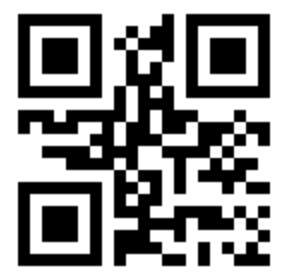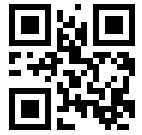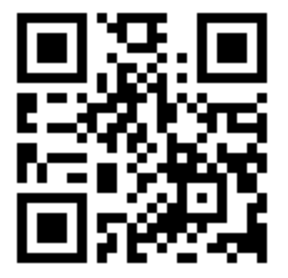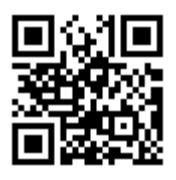Description of QR Code & GS1 QR Code
 The QR code is a modern square 2D code. QR Code stands for Quick Response Code. The name reflects its ability to be quickly scanned and decoded, providing users with instant access to the information encoded within the code.
The QR code is a modern square 2D code. QR Code stands for Quick Response Code. The name reflects its ability to be quickly scanned and decoded, providing users with instant access to the information encoded within the code.The marks in three of the four corners of the matrix provide the orientation. Due to automatic error correction, the QR code is very robust and therefore widespread.
Which of the numerous types should I use to create a QR Code?
Usually you simply select the QR Code type. This will generate the smallest possible QR Code.
If you want to work with a fixed error correction, please select one of the following 4 types:
- QR Code ECC LEVEL L : 7% of the data can be restored.
- QR Code ECC LEVEL M : 15% of the data can be restored.
- QR Code ECC LEVEL Q : 25% of the data can be restored.
- QR Code ECC LEVEL H : 30% of the data can be restored.
Alternatively, you can specify the symbol size if you need a constant size. Select one of the types with fixed-size for this purpose, e.g. QR Code 45x45. The error correction is then selected automatically as good as possible depending on the amount of data.
List of the QR Code symbol sizes, complete with examples.Link
Each of these represents a different symbol size of the QR Code code. The choice determines how much data can be encoded and how large the code will appear.
Each of these represents a different symbol size of the QR Code. The choice determines how much data can be encoded and how large the code will appear.
Smaller symbols (e.g. 21x21, 25x25) can hold less data but take up less space. Larger symbols can store more characters or additional GS1 elements.
If your data content always stays short, then using a smaller symbol is perfectly fine. If you later add more information, you'll need to select a larger version so the data still fits.
The choice partly depends on the amount of data and partly on the available space. ActiveBarcode automatically ensures that whichever size you pick still produces a valid, scannable QR Code.
If you choose a fixed type such as 65x65, that specific symbol size will be enforced, even if a smaller and more compact code would also work.
ActiveBarcode offers five automatic types: AUTO, ECC Level L, ECC Level M, ECC Level Q and ECC Level H. These always select the smallest possible symbol size that can accommodate all your data.
If you want to work with a fixed error correction, please select one of the following 4 types:
Smaller symbols (e.g. 21x21, 25x25) can hold less data but take up less space. Larger symbols can store more characters or additional GS1 elements.
If your data content always stays short, then using a smaller symbol is perfectly fine. If you later add more information, you'll need to select a larger version so the data still fits.
The choice partly depends on the amount of data and partly on the available space. ActiveBarcode automatically ensures that whichever size you pick still produces a valid, scannable QR Code.
If you choose a fixed type such as 65x65, that specific symbol size will be enforced, even if a smaller and more compact code would also work.
ActiveBarcode offers five automatic types: AUTO, ECC Level L, ECC Level M, ECC Level Q and ECC Level H. These always select the smallest possible symbol size that can accommodate all your data.
If you want to work with a fixed error correction, please select one of the following 4 types:
- QR Code ECC LEVEL L : 7% of the data can be restored.
- QR Code ECC LEVEL M : 15% of the data can be restored.
- QR Code ECC LEVEL Q : 25% of the data can be restored.
- QR Code ECC LEVEL H : 30% of the data can be restored.
Many use cases have developed around the QR code. The international organization GS1 plays a crucial role in the world of product identification and supply chain management and uses the QR code. Encoding URLs, WiFi passwords, GEO locations and vCards are just some examples. They all use the QR code to encode this data, and it's just a matter of formatting that data. Sometimes you just need to start the text with a special tag:
 GS1 Application Identifier (AI):
GS1 Application Identifier (AI):
To encode GS1, start with the special sequence ]Q3.
When using application identifiers, omit the parentheses.
Say you want to encode:
(01)01234567890128(15)051231 you have to set the text as: ]Q3010123456789012815051231. Only if the application identifier has a variable data length like (30) Count of items the data has to be closed with <GS> to signal the end of that specific application identifier. Say you want to encode:
Only if the application identifier has a variable data length like (30) Count of items the data has to be closed with <GS> to signal the end of that specific application identifier. Say you want to encode:
(30)19<GS>(21)12345678912 you have to set the text as: ]Q33019<GS>2112345678912.
Scanning these QR Codes with GS1 application identifier will decode all application identifiers as desired: List of Application Identifiers https://
https://
If you want to encode an URL you'll use this format:
https://www.activebarcode.com.
If you scan that QR Code with your smartphone you can visit that URL directly without entering that URL. geo:
geo:
If you want to encode a GEO location you'll use this format:
geo:52.5186234,13.3739932.
If you scan that QR Code with your smartphone you can visit that place with the maps application.- vCard:
If you want to encode a vCard you can use this as a template to start with. If you scan that QR Code with your smartphone you can add the encoded data to your contacts.BEGIN:VCARD<LF> VERSION:2.1<LF> N:Gump;Forrest<LF> FN:Forrest Gump<LF> ORG:Bubba Gump Shrimp Co.<LF> TITLE:Shrimp Man<LF> PHOTO;GIF:http://www.example.com/dir_photos/my_photo.gif<LF> TEL;WORK;VOICE:(111) 555-1212<LF> TEL;HOME;VOICE:(404) 555-1212<LF> ADR;WORK:;;100 Waters Edge;Baytown;LA;30314;United States of America<LF> LABEL;WORK;ENCODING=QUOTED-PRINTABLE:100 Waters Edge=0D=0ABaytown, LA 30314=0D=0AUnited States of America<LF> ADR;HOME:;;42 Plantation St.;Baytown;LA;30314;United States of America<LF> LABEL;HOME;ENCODING=QUOTED-PRINTABLE:42 Plantation St.=0D=0ABaytown, LA 30314=0D=0AUnited States of America<LF> EMAIL;PREF;INTERNET:[email protected]<LF> REV:20080424T195243Z<LF> END:VCARD
Video: How to add a vCard QR code into an image.
Link to the REST API to demo how to create such barcode.
QR Code is registered trademark of DENSO WAVE INCORPORATED. Intensive technical background information can be found at: http://en.wikipedia.org/wiki/QR_code.
Technical data
| Valid characters: | ASCII 1-255 |
| Length: | Variable with no fixed length. |
| Check digit: |
Calculated according to Reed-Solomon-Error correction ActiveBarcode calculates the check digit automatically. |
| Type#: |
QR Code - #113 - QRCODE List of all symbol sizes |
| Info: | This barcode types has no human readable text based on the specification. The ShowText property has no effect, when using one of this codes. |











































